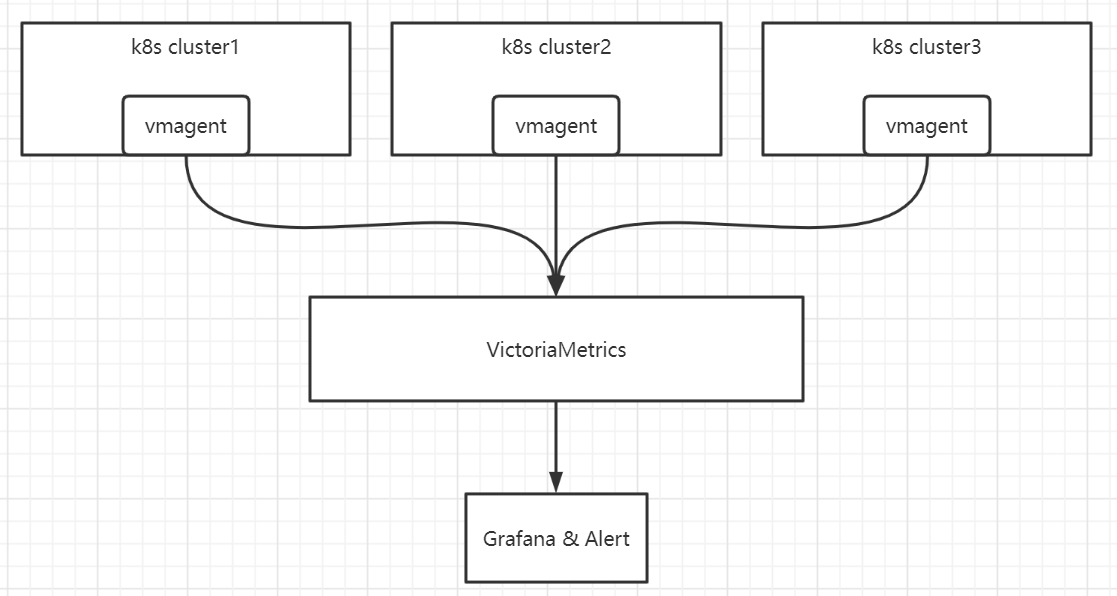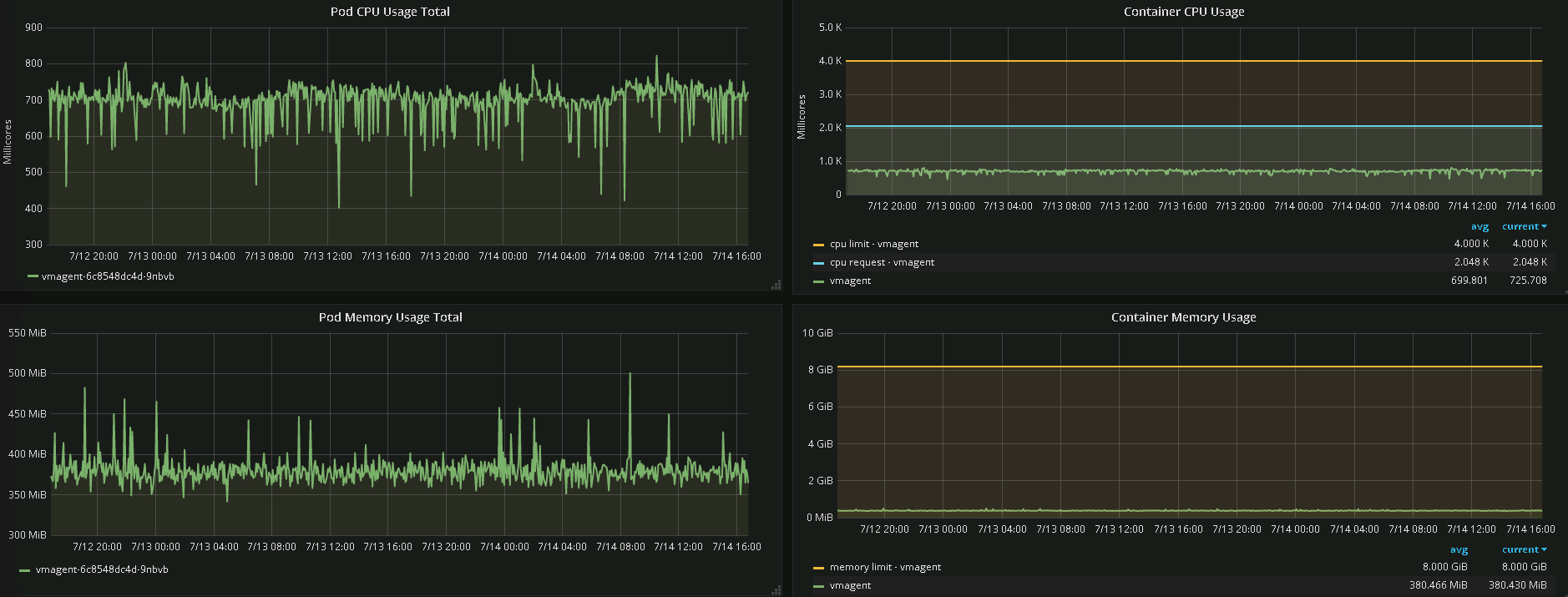I. What is vmagent
The following is the original official documentation.
vmagent is a tiny but powerful agent that helps us collect metrics from different sources and store them in vm or other prometheus-compatible storage systems that support the remote_write protocol.
Features of vmagent
- Supports as a replacement for prometheus for grabbing data from, for example, node_exporter
- Can read data from Kafka. See these documents.
- Data can be written to Kafka. See these documents.
- Labels (relabel) can be added, removed, and modified via Prometheus relabeling. Data can be filtered before it is sent to remote storage. For more information, see these documents.
- Receive data via all ingestion protocols supported by VictoriaMetrics - see these documents.
- Can replicate collected metrics to multiple remote storage systems simultaneously.
- Works smoothly in environments with unstable connections to remote storage. If remote storage is not available, the collected metrics are cached in
-remoteWrite.tmpDataPath. Once the connection to the remote storage is repaired, the cached metrics are sent to the remote storage. You can use Limit the maximum disk usage of the buffer -remoteWrite.maxDiskUsagePerURL.
- Uses less RAM, CPU, disk IO, and network bandwidth than Prometheus.
vmagent When a large number of targets must be crawled, the crawl targets can be distributed among multiple instances. See these documents.- Targets that expose millions of time series, such as the /federate endpoint in Prometheus, can be efficiently crawled. See these documents.
- High base and high churn can be handled by limiting the number of unique time series before they are crawled and sent to a remote storage system. Please refer to these documents.
- Crawl configurations can be loaded from multiple files. See these documents.
II. Architecture diagram
- Metrics collected by vmagent include: node-exporter, kubernetes-cadvisor, kube-state-metrics
- vmagent collects and sends to VictoriaMetrics on the monitoring team

III. Deployment
namespace.yml
1
2
3
4
|
apiVersion: v1
kind: Namespace
metadata:
name: sbux-monitoring
|
serviceaccount.yml
1
2
3
4
5
|
apiVersion: v1
kind: ServiceAccount
metadata:
name: vmagent
namespace: sbux-monitoring
|
clusterrole.yml
1
2
3
4
5
6
7
8
9
10
11
12
13
14
15
16
17
18
19
20
21
|
apiVersion: rbac.authorization.k8s.io/v1
kind: ClusterRole
metadata:
name: vmagent
rules:
- apiGroups: ["", "networking.k8s.io", "extensions"]
resources:
- nodes
- nodes/metrics
- services
- endpoints
- endpointslices
- pods
verbs: ["get", "list", "watch"]
- apiGroups: [""]
resources:
- namespaces
- configmaps
verbs: ["get"]
- nonResourceURLs: ["/metrics", "/metrics/resources"]
verbs: ["get"]
|
clusterrolebinding.yml
1
2
3
4
5
6
7
8
9
10
11
12
|
apiVersion: rbac.authorization.k8s.io/v1
kind: ClusterRoleBinding
metadata:
name: vmagent
roleRef:
apiGroup: rbac.authorization.k8s.io
kind: ClusterRole
name: vmagent
subjects:
- kind: ServiceAccount
name: vmagent
namespace: sbux-monitoring
|
configmap-vmagent.yml
The vmagent profile, depending on the actual requirements, needs to capture node-exporter, cadvisor, and kube-state-metrics metrics.
global.external_labels field: configured as the name of each cluster
scrape_timeout : I set 60 seconds, the actual test kube-state-metrics metrics are sometimes slow to pull, in addition to adjusting this timeout, you should also adjust the CPU and memory configuration of the kube-state-metrics pod.
1
2
3
4
5
6
7
8
9
10
11
12
13
14
15
16
17
18
19
20
21
22
23
24
25
26
27
28
29
30
31
32
33
34
35
36
37
38
39
40
41
42
43
44
45
46
47
48
49
50
51
52
53
54
55
56
57
58
59
60
61
|
apiVersion: v1
kind: ConfigMap
metadata:
name: vmagent-config
namespace: sbux-monitoring
data:
scrape.yml: |
global:
scrape_interval: 30s
scrape_timeout: 60s
external_labels:
cluster: gds-poc
scrape_configs:
- job_name: 'vmanent'
static_configs:
- targets: ['vmagent:8429']
- job_name: 'node-exporter'
kubernetes_sd_configs:
- role: endpoints
relabel_configs:
- source_labels: [__meta_kubernetes_endpoints_name]
regex: node-exporter
action: keep
- source_labels: [__meta_kubernetes_namespace]
regex: kube-system
action: keep
- source_labels: [__meta_kubernetes_pod_node_name]
target_label: cps_node_name
- job_name: 'kubernetes-cadvisor'
scheme: https
tls_config:
ca_file: /secrets/kubelet/ca
key_file: /secrets/kubelet/key
cert_file: /secrets/kubelet/cert
metrics_path: /metrics/cadvisor
kubernetes_sd_configs:
- role: node
relabel_configs:
- action: labelmap
regex: __meta_kubernetes_node_label_(.+)
- source_labels: [__meta_kubernetes_node_name]
regex: (.+)
target_label: cps_node_name
replacement: $1
- job_name: 'kube-state-metrics'
kubernetes_sd_configs:
- role: endpoints
relabel_configs:
- source_labels: [__meta_kubernetes_endpoints_name]
action: keep
regex: kube-state-metrics
- source_labels: [__meta_kubernetes_namespace]
action: keep
regex: kube-system
|
secret_kubelet.yml
The cadvisor job uses tls, so it needs to mount the kubelet’s certificate.
1
2
3
|
#Use the kube-client-tls-secret under the kube-system namespace
#Modify namespace fields, remove creationTimestamp, resourceVersion, selfLink, uid, etc.
~]$ kubectl -n kube-system get secret kubelet-client-tls-secret -oyaml > secret_kubelet.yml
|
deployment.yml
Command-line parameters.
-promscrape.config=/config/scrape.yml Specify the path to the vmagent’s configuration file, such as the volumeMounts field-remoteWrite.tmpDataPath=/tmpData, -remoteWrite.maxDiskUsagePerURL=10GB Specify the temporary storage directory for monitoring metrics as /tmpData, the maximum available temporary directory is 10GB.-remoteWrite.url=http://victoriametrics.victoriametrics:8428/api/v1/write, -remoteWrite.url=https://prometheus-vminsert.xxxxxx. net/insert/0/prometheus specifies two remote write addresses, one for my own test victoriametrics and one for the monitoring team’s victoriametrics-remoteWrite.tlsInsecureSkipVerify=true Because the https certificate of the remote write address is self-signed, so you need to configure this option, production environments are recommended to add basicauth configuration to strengthen security-promscrape.maxScrapeSize=50MB The maximum size of scrape response. in actual testing, when the number of applications in the cluster is large, the response will exceed 20MB.
1
2
3
4
5
6
7
8
9
10
11
12
13
14
15
16
17
18
19
20
21
22
23
24
25
26
27
28
29
30
31
32
33
34
35
36
37
38
39
40
41
42
43
44
45
46
47
48
49
50
51
52
53
54
55
56
57
|
---
apiVersion: apps/v1
kind: Deployment
metadata:
name: vmagent
namespace: sbux-monitoring
labels:
app: vmagent
spec:
selector:
matchLabels:
app: vmagent
template:
metadata:
labels:
app: vmagent
spec:
serviceAccountName: vmagent
containers:
- name: vmagent
image: "registry.xxxxxx.net/library/vmagent:v1.77.1"
imagePullPolicy: IfNotPresent
args:
- -promscrape.config=/config/scrape.yml
- -remoteWrite.tmpDataPath=/tmpData
- -promscrape.maxScrapeSize=50MB
- -remoteWrite.maxDiskUsagePerURL=10GB
- -remoteWrite.url=http://victoriametrics.victoriametrics:8428/api/v1/write
- -remoteWrite.url=https://prometheus-vminsert.xxxxxxcf.net/insert/0/prometheus
- -remoteWrite.tlsInsecureSkipVerify=true
- -envflag.enable=true
- -envflag.prefix=VM_
- -loggerFormat=json
ports:
- name: http
containerPort: 8429
resources:
limits:
cpu: "4"
memory: 8Gi
requests:
cpu: "1"
memory: 1Gi
volumeMounts:
- name: config
mountPath: /config
- name: kubelet-client-tls-secret
mountPath: /secrets/kubelet
volumes:
- name: config
configMap:
name: vmagent-config
- name: kubelet-client-tls-secret
secret:
defaultMode: 420
optional: true
secretName: kubelet-client-tls-secret
|
service.yml
1
2
3
4
5
6
7
8
9
10
11
12
13
14
15
16
17
|
---
apiVersion: v1
kind: Service
metadata:
labels:
app: vmagent
name: vmagent
namespace: sbux-monitoring
spec:
ports:
- name: http-8429
port: 8429
protocol: TCP
targetPort: 8429
selector:
app: vmagent
type: ClusterIP
|
IV. Problems encountered
kube-state-metrics metrics are not available, and the vmagent reports errors
1
|
{"ts":"2022-05-30T13:20:16.594Z","level":"error","caller":"VictoriaMetrics/lib/promscrape/scrapework.go:355","msg":"error when scraping \"http://192.168.154.27:8080/metrics\" from job \"kube-state-metrics\" with labels {cluster=\"prod-azure\",instance=\"192.168.154.27:8080\",job=\"kube-state-metrics\"}: cannot read Prometheus exposition data: cannot read a block of data in 0.000s: the response from \"http://192.168.154.27:8080/metrics\" exceeds -promscrape.maxScrapeSize=16777216; either reduce the response size for the target or increase -promscrape.maxScrapeSize"}
|
Solution: Increase promscrape.maxScrapeSize.
kube-state-metrics metrics pull timeout
Solution: The configuration of the kube-state-metrics application is too low, CPU memory is adjusted upwards. vmagent configuration file inside the scrape timeout is changed to 60s.
dashboard
V. Resource consumption
Basically 1C1G is enough
- node nodes: 400
- pod number: 4500 (790 of them are business pods, the rest are system components and so on)
- deployment: 191 (131 of them are business applications, the rest are system components)


